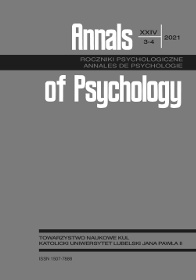Film Preferences in the Pandemic: Psychological Resilience or an Escape from the Pandemic Reality?
Abstract
During the last year, the one of COVID-19 pandemic, the lives of many people have changed in many ways, one of them is media consumption. We wanted to verify whether “stay at home” recommendations influenced viewers’ preferences concerning films, their watching habits, motivation to choose a specific film and how media use is related to some psychological variables, mainly a sense of loneliness, self-esteem and pandemic psychological resilience. Results of the online survey showed that participants watch more films or series during the pandemic than before and that they prefer various genres. They more often use streaming platforms and go to the cinema less frequently compared to the period before the pandemic. Participants watch films more for both entertainment and as a way to get away from everyday reality than before. Cast, film topic and recommendations became less important when choosing a film. There was also found a weak, however significant correlation between describing oneself as a fan of a specific film genre and the pandemic psychological resilience. Results show that the pandemic psychological resilience is moderately, negatively related to loneliness. A positive, however weak, relation of pandemic psychological resilience to self-esteem was also found.
References
Bordwell, D. (1985). Narration in the fiction film. University of Wisconsin Press.
Branigan, E. (1999). Schemat fabularny [Plotline]. In J. Ostaszewski (Ed.), Kognitywna teoria filmu. Antologia przekładów (pp. 112–154). Wydawnictwo Baran i Suszyński.
Dzwonkowska, I., Lachowicz-Tabaczek, K., & Łaguna, M. (2008). Samoocena i jej pomiar SES. Polska adaptacja skali SES M. Rosenberga [Self-esteem and its measurement SES. Polish adaptation of the SES scale by M. Rosenberg]. Pracownia Testów Psychologicznych.
Francuz, P. (2002). Rozumienie przekazu telewizyjnego. Psychologiczne badania telewizyjnych programów informacyjnych [Understanding the television broadcast. Psychological study of television news programs]. Towarzystwo Naukowe KUL.
Grygiel, P., Humenny, G., Rębisz, S., Świtaj, P., & Sikorska-Grygiel, J. (2012). Validating the Polish adaptation of the 11-item De Jong Gierveld Loneliness Scale. European Journal of Psychological Assessment, 29, 129–139. https://doi.org/10.1027/1015-5759/a000130
Kołodziej, E. (2020, December 10). Netflix podsumował mijający rok. Te filmy i seriale najchętniej oglądaliśmy w 2020 roku [Netflix has summed up the past year. These movies and series were the most watched in 2020]. Noizz.pl. https://noizz.pl/film/netflix-podsumowal-mijajacy-rok-tonajchetniej-ogladali-polacy/5tvg9x9
Lang, A. (2006). The limited capacity model of mediated message processing. Journal of Communication, 50, 46–70. https://doi.org/10.1111/j.1460-2466.2000.tb02833.x
McQuail, D. (2008). Teoria komunikowania masowego [Mass communication theory] (Alina Szulżycka & Marta Bucholc, Trans.). Wydawnictwo Naukowe PWN.
Münsterberg, H. (1989). Dramat kinowy. Studium psychologiczne [The Photoplay. A Psychological Study]. Łódzki Dom Kultury.
Ohler, P. (1999). Kognitywna teoria percepcji filmu. Koncepcja przetwarzania informacji [Cognitive theory of film perception. The concept of information processing]. In J. Ostaszewski (Ed.), Kognitywna teoria filmu. Antologia przekładów (pp. 330–345). Wydawnictwo Baran i Suszyński.
Polański, G. (2017). Gratyfikacje z korzystania z mediów [Gratifications of media use]. Edukacja –Technika – Informatyka, 8(3), 250–255.
Scalise-Sugiyama, M. (2001). Food, foragers, and folklore: The role of narrative in human subsistence. Evolution and Human Behavior, 22(4), 221–240. https://doi.org/10.1016/S1090-5138(01)00063-0
Scrivner, C., Johnson, J. A., Kjeldgaard-Christiansen, J., & Clasen, M. (2021). Pandemic practice: Horror fans and morbidly curious individuals are more psychologically resilient during the COVID-19 pandemic. Personality and Individual Differences, 168, 110397. https://doi.org/10.1016/j.paid.2020.110397
Turska-Kawa, A. (2013). Media jako źródło zaspokajania fundamentalnych potrzeb. Rozważania w kontekście teorii „użytkowania i gratyfikacji” [Media as a source of satisfying fundamental needs. Considerations in context of the „uses and gratifications” theory]. Studia Politicae Universitatis Silesiensis, 10, 147–172.
Williams, S. N., Armitage, C. J., Tampe, T., & Dienes, K. (2020). Public perceptions and experiences of social distancing and social isolation during the COVID-19 pandemic: A UK-based focus group study. medRxiv. https://www.medrxiv.org/content/10.1101/2020.04.10.20061267v1
Wühr, P., Lange, B. P., & Schwarz, S. (2017). Tears or fears? Comparing gender stereotypes about movie preferences to actual preferences. Frontiers in Psychology, 8:428. doi: 10.3389/fpsyg.2017.00428
Copyright (c) 2021 Annals of Psychology

This work is licensed under a Creative Commons Attribution-NonCommercial-NoDerivatives 4.0 International License.


